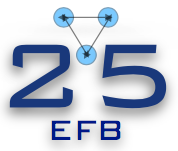Speaker
Description
Combining the hyperspherical harmonics (HH) method with the Rayleigh-Ritz or Kohn variational principle leads to one of the most accurate techniques to study microscopically both bound and scattering states for nuclear systems with a number of nucleons A ≤ 4 [1]. However, describing systems with A ≥ 4 remains a computational challenge. One reason for that is the rapid growth of the number of hyperspherical harmonics with A, for a given grand angular momentum. Another reason is the increasing difficulty with A to build a maximal set of linearly independent antisymmetric hyperspherical states for each considered set of total orbital angular momentum, total spin, and total isospin [2]. In this contribution, I will present a new method to bypass this latter difficulty. In this approach, the wave function is expanded on a nonsymmetrized HH basis and then, antisymmetrized on-the-fly when solving iteratively the eigenvalue problem (in the bound-state case) or the linear systems (in the scattering case) resulting of the application of the Rayleigh-Ritz or Kohn variational principle. The efficiency and the accuracy of the method is tested on some nuclear systems with up to six nucleons, interacting via two-body forces. Possible future applications include the description of several important reactions, like the α+N scattering, the t+d→α+n “fusion” reaction, or the α +d→6Li+γ radiative capture.
[1] L. E. Marcucci, J. Dohet-Eraly, L. Girlanda, A. Gnech, A. Kievsky, and M. Viviani, Front. Phys. 8 (2020) 69.
[2] J. Dohet-Eraly and M. Viviani, Comput. Phys. Commun. 253 (2020) 107183.

